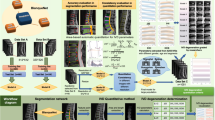Abstract
Lumbar disc diagnosis belongs to Magnetic Resonance Imaging (MRI) segmentation and detection. It is a challenge for even the most professional radiologists to manually check and interpret MRI. In addition, high-class imbalance is a typical problem in diverse medical image classification problems, which results in poor classification performance. Data imbalance is a typical problem in medical image classifications. Recently computer vision and deep learning are widely used in the automatic positioning and diagnosis of intervertebral discs to improve diagnostic efficiency. In this work, a two-stage disc automatic diagnosis network is proposed, which can improve the accuracy of training classifiers with imbalanced dataset. Experimental results show that the proposed method can achieve 93.08%, 95.41%, 96.22%, 89.34% for accuracy, precision, sensitivity and specificity, respectively. It can solve the problem of imbalanced dataset, and reduce misdiagnosis rate.
Access this chapter
Tax calculation will be finalised at checkout
Purchases are for personal use only
Similar content being viewed by others
References
Liu, J., Huang, X., Luo, Y., Cao, Y.: An energy-aware hybrid particle swarm optimization algorithm for spiking neural network mapping. In: Liu, D., Xie, S., Li, Y., Zhao, D., El-Alfy, E.S. (eds.) International Conference on Neural Information Processing, ICONIP 2017, LNCS, vol. 10636, pp. 805–815, Springer, Cham (2017). https://doi.org/10.1007/978-3-319-70090-8_82
Fu, Q., et al.: Improving learning algorithm performance for spiking neural networks. In: 2017 17th IEEE International Conference on Communication Technology (ICCT 2017), pp. 1916–1919 (2018)
Luo, Y., et al.: Forest fire detection using spiking neural networks. In: CF 2018: Proceedings of the 15th ACM International Conference on Computing Frontiers, pp. 371–375 (2018)
Liu, J., et al.: Exploring self-repair in a coupled spiking astrocyte neural network. IEEE Trans. Neural Netw. Learn. Syst. 30(3), 865–875 (2019)
Siewerdsen, J.H., et al.: Automatic vertebrae localization in spine CT: a deep-learning approach for image guidance and surgical data science. In: Medical Imaging 2019: Image-Guided Procedures, Robotic Interventions, and Modeling, pp. 1–8 (2019)
Zhou, Y., Liu, Y., Chen, Q., Gu, G., Sui, X.: Automatic lumbar MRI detection and identification based on deep learning. J. Digit. Imag. 32(3), 513–520 (2019)
Jamaludin, A., Kadir, T., Zisserman, A.: SpineNet: automated classification and evidence visualization in spinal MRIs. Med. Image Anal. 41(1), 63–73 (2017)
Lootus, M., Kadir, T., Zisserman, A.: Vertebrae Detection and Labelling in Lumbar MR Images. In: Yao, J., Klinder, T., Li, S. (eds.) Computational Methods and Clinical Applications for Spine Imaging. LNCVB, vol. 17, pp. 219–230. Springer, Cham (2014). https://doi.org/10.1007/978-3-319-07269-2_19
Glocker, B., Zikic, D., Konukoglu, E., Haynor, D.R., Criminisi, A.: Vertebrae localization in pathological spine CT via dense classification from sparse annotations. In: Mori, K., Sakuma, I., Sato, Y., Barillot, C., Navab, N. (eds.) MICCAI 2013. LNCS, vol. 8150, pp. 262–270. Springer, Heidelberg (2013). https://doi.org/10.1007/978-3-642-40763-5_33
He, X., Landis, M., Leung, S., Warrington, J., Shmuilovich, O., Li, S.: Automated grading of lumbar disc degeneration via supervised distance metric learning. In: Proceedings of SPIE, vol. 10134(1), pp. 1–7 (2017)
Liu, J., et al.: Financial data forecasting using optimized echo state network. In: Cheng, L., Leung, A.C.S., Ozawa, S. (eds.) ICONIP 2018. LNCS, vol. 11305, pp. 138–149. Springer, Cham (2018). https://doi.org/10.1007/978-3-030-04221-9_13
Acknowledgments
This research was partially supported by the National Natural Science Foundation of China under Grant 61976063, the funding of Overseas 100 Talents Program of Guangxi Higher Education under Grant F-KA16035, the Diecai Project of Guangxi Normal University, 2018 Guangxi One Thousand Young and Middle-Aged College and University Backbone Teachers Cultivation Program, research fund of Guangxi Key Lab of Multi-source Information Mining & Security (19-A-03-02), research fund of Guangxi Key Laboratory of Wireless Wideband Communication and Signal Processing, and the Young and Middle-aged Teachers’ Research Ability Improvement Project in Guangxi Universities under Grant 2020KY02030.
Author information
Authors and Affiliations
Corresponding authors
Editor information
Editors and Affiliations
Rights and permissions
Copyright information
© 2020 Springer Nature Switzerland AG
About this paper
Cite this paper
Liang, X., Liu, J., Luo, Y., Wu, G., Zhang, S., Qiu, S. (2020). Automatic Segmentation and Diagnosis of Intervertebral Discs Based on Deep Neural Networks. In: Yang, H., Pasupa, K., Leung, A.CS., Kwok, J.T., Chan, J.H., King, I. (eds) Neural Information Processing. ICONIP 2020. Communications in Computer and Information Science, vol 1332. Springer, Cham. https://doi.org/10.1007/978-3-030-63820-7_19
Download citation
DOI: https://doi.org/10.1007/978-3-030-63820-7_19
Published:
Publisher Name: Springer, Cham
Print ISBN: 978-3-030-63819-1
Online ISBN: 978-3-030-63820-7
eBook Packages: Computer ScienceComputer Science (R0)




